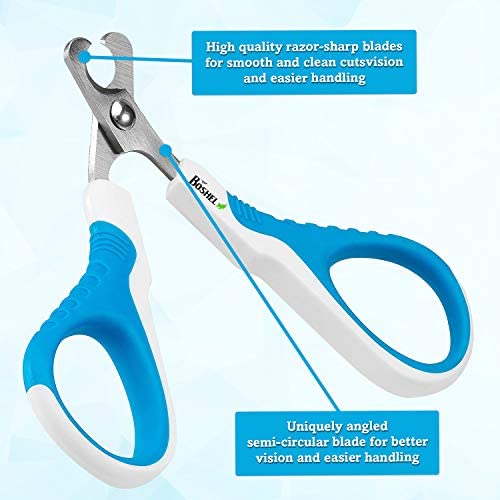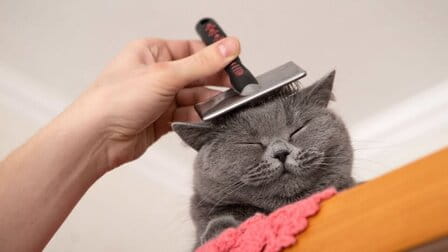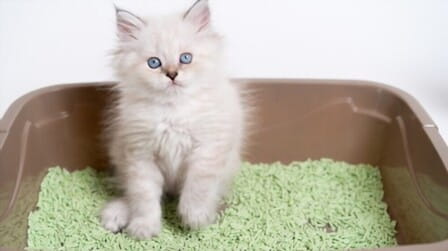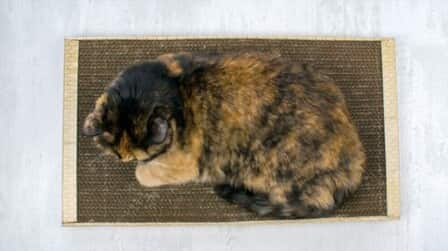You'll need to clean and sanitize your cat's claws, trim the nails to keep them from splitting or breaking, and may find cutting off the sharp ends of your cat's claws if your cat tends to knead, scratch, etc. Clipping a cat's nails is not easy and you need to get used to it. The article on how to trim cats' nails will answer your questions.

1. Your cat
1.1 Stroking a cat's paw
Most cats are a bit uncomfortable when touched by their paws, so start by helping your cat get used to this. When you wait a while as your cat relaxes and lays down.
Begin gently stroking the cat's paws while stroking in areas that the cat likes (the back of the neck, under the chin, where the back meets the tail, etc.). Furthermore, you should do this for each foot you intend to cut.
The cat can pull back at any moment, or even get up and walk away. Therefore, let it go; Do not force it to do anything but continue to gently stroke its paws when the opportunity arises.
On the other hand, whenever you touch your cat's paws, reward him with gifts and praise to help build a positive bond.
1.2 Hold the cat's paws
Once the cat is comfortable enough to be able to put your hand on its paw without jerking away, begin to gently hold its paw in the open hand.
Place your hand on the cat's paws, then flip the hand so that the bottom of the cat's paw rests on the palm.
Continue to reward the cat with petting and feeding; Give the cat a new, special treat that will only involve clipping its claws.
1.3 Massage the cat's paws

Once your cat gets used to holding its paws, start holding and massaging them with your fingers.
Gently massage your fingers on the top and bottom of each foot to be cut. Besides, you should also give the cat more rewards and praise.
1.4 Look closely at the cat's claws
You can gently squeeze the paws (putting most of the pressure on the pad) to push each claw out without disturbing the cat.
As the cat's claws extend out, you should see the thick part of the nail and towards the cat's toe, a pink area inside the nail called the claw.
The fast nail is the base of the nail, which contains blood vessels and nerves, so cutting a cat's nail can be quite painful. Never trim a cat's nails near or with its toes; The goal is to cut off only the sharp part.
So carefully consider the position and size of each snap - through a transparent nail, it should look like a small pink triangle. Every cat's claw will look the same, so even if your cat has dark nails, look for a transparent nail to use as a reference point for the others.
1.5 Create a sense of comfort
If your cat is already comfortable sitting in the correct position to trim his nails, he will be less likely to fight during the actual nail clipping.
If you're going to trim your cat's nails on her own, she'll have to sit back on your lap, facing away from you, while you hold her paw with one hand (and eventually hold the nail clipper with the other). ).
Practice getting the cat to sit this way and hold each of its paws. Gently press on each nail to lengthen it. Again, reward the cat with praise and treats.
If someone helps, they can hold the cat facing you, or they can hold it while you hold the paw with one hand (and eventually clamp with the other).
Practice letting the assistant hold the cat while you hold each of its paws and gently press each claw until your cat seems comfortable. Reward it with snacks and praise.
2. Cut your cat's nails yourself
2.1 Wait for the right time
You can't trim your cat's nails whenever you want. So the time when the cat feels comfortable and at ease, like when it's just napping, getting ready to sleep, or lying still on its favorite surface for the day.
Another good time to trim the nails is after the cat has finished eating, feeling sleepy and satisfied.
Don't try to trim your cat's nails right after playtime, when the cat is hungry, restless, running around, or in an aggressive mood. The cat will not cooperate with you to cut its nails.
You may see your cat break or split and want to cut it right away, but don't do it. Therefore, you should wait for your cat to relax before trying to cut it, or you could make the condition worse.
2.2 Using the right tools
When sitting to trim your cat's nails, make sure the equipment is suitable for the job. To trim a cat's nails, you will need a nail clipper designed to cut cats' nails and a bleeding pencil.
Choose from several nail clippers that all do the same job. The clippers must be sharp, so they cut straight through the claws. Using a blunt trimmer not only makes the job longer and harder, but it can also squeeze the trimmer quickly, which can be painful for the cat. There are two main types of trimmer: scissor trimmer and slash trimmer.
Cat nail clippers use a scissor motion and are usually small and large. Small "nippers" tend to be better for those who are new to nail trimming or just need to trim the tips of their nails. Larger scissors are suitable for cutting older and harder nails.
Nail scissors use a sliding blade to cut nails as you squeeze the handles together. The nail fits into a groove and the blade slides horizontally to clamp the nail. These are known to be powerful scissors, suitable for cutting long, thick nails (but not overgrown nails - large scissors are suitable)
If you press sharply, the cat will not feel the quick click. Scissors don't sharpen forever, so discard them (or send them for re-sharpening) if the blade becomes dull. Signs of this include having to use a lot of force to cut the nail or the nail being "gnawed" by the clippers rather than cutting it cleanly.
In addition, you should also have a bleeding pencil ready in case you are cutting your cat's cut quickly because a cat's quick cut is much shorter. Hemostatic pencils are available in pharmacies (shaving area). They burn blood vessels to the touch of the nail and help stop bleeding. If you cut quickly, you can hold the bleeding pencil against the nail for 1-2 minutes and the bleeding will stop.
2.3 Place the cat in the "nail clipping position", with its back on your lap and it's back to you.
Hold the trimmer with one hand and hold the cat's paw with the other.
Gently squeeze the top and bottom of the cat's claw, at the joint just behind the nail, to widen the nail.
2.4 Find nails that separate quickly
Make sure where the quick cut is before attempting to cut the nail - the quick cut should look like a small, pale pink triangle inside the nail.
You should cut the tip of the nail first, and when you feel more comfortable, you can cut close to the nail, but never all the way, or you may injure the cat and bleed the nail.
2.5 Trim nail clippers
Hold the cat as described earlier and trim the nails one at a time. Position the trimmer between the end of the quick and the claw.
Try to orient the press so that when cutting the nail, the blade cuts from the bottom to the top. This will help prevent splits.
Calm the cat and don't yell at the cat or rush to do it, or you may hurt it and scare it off by trimming its nails.
At first, only one or two nails can be cut at a time.
2.6 Choose the right treatment
Sport or cook something special: vacuum-packed salmon or chicken. Some cats also like butter or sour cream.
Using a special treat ensures that the cat begins to associate this reward with nail clipping. So, although the cat may not like the nail clipping, it will want to enjoy the food afterward, so it will be less resistant in the future.
2.7 Check the cat's nails
Every cat's nails grow at a different rate, but as a general rule, it's a good idea to trim your cat's nails somewhere between two weeks and every month so their nails don't get too long, split, or broken.
While they can sharpen their claws on their own and keep them in good condition, however, keep an eye on their nails. The cat can break its claws when walking around and can help it by trimming them into shape.
Large cats need special attention because their nails are thicker and can sometimes press around the pads, cutting into them. Check your big cat's nails weekly and trim them if necessary.
3. Seeking help
3.1 Choose a support person
Get help from a family member or friend who often comes to the house.
While it sounds good and okay to get your cat used to nail clipping, the reality is that many cats will still protest each time and you may need extra help with this.
3.2 Find someone to help hold the cat in place
Both can try standing on opposite sides of a raised surface, such as a counter. Or talk calmly and reassure the cat. On the other hand, have a helper pet the cat and try to keep it in place by hugging its body tightly without injuring it or getting too scared.
If the cat likes to be groomed, the other person can brush the cat to distract it from the fact that it is getting its nails trimmed. Have a helper brush her hair, under the neck, or in other places, the cat likes to be brushed.
3.3 Hold the cat's paw
While holding the foot, press down on the pad to extend the claw.
If the cat is noisy, wait for it to settle down so you can isolate the paws.
3.4 Cat nail clippers

The helper will continue to distract the cat while clipping its claws.
Just follow the instructions in the previous section to make sure you trim your cat's nails smoothly, and painlessly.
When you're done, reward the cat with a delicious treat.
3.5 Check the cat's claw

Every cat's nails will grow at a different rate, but it's a good idea to trim your cat's nails somewhere between two weeks and every month so their nails don't become too long, split, or broken.
While the cat will probably sharpen its claws and keep them in good condition, however, keep an eye on its nails. The cat can break its claws when walking around and you can help it by trimming it into shape.
Large cats need special attention because their nails are thicker and can sometimes press around the pads and cut into them. Check your older cat's nails every week and trim them if needed. This is much easier than letting the nails overgrow which can cause them to hit the pads. If this happens, the cat needs to see a veterinarian as antibiotics may be needed.
Also, don't forget the dew claw. Cats usually have two claws, one on each front paw. They are like a small thumb, located on one side of the front leg, just below the wrist. Since these claws are not used much, they tend to be overgrown and healthy kittens need to be checked every month.
Start with stroking the back first. Many cats will try to use their hind legs to get out, but if you've cut them, it's not easy to get scratched.
Many cats can be clipped while they are sleeping next to their companions. If you remember to leave your nail clippers on, this much-needed cat care job can be completed without disturbing your cat's important rest time.
Conclusion
Through our sharing above, you should check your nails carefully because the cat's claw structure has two claws, one on each front paw. They are like a small thumb, located on one side of the front leg, just below the wrist. On the other hand, you should also stroke your back first. Many cats will try to use their hind legs to get out, and cutting tools must be safe and disinfected. The discussion about how to trim cats' nails will be your answer.













